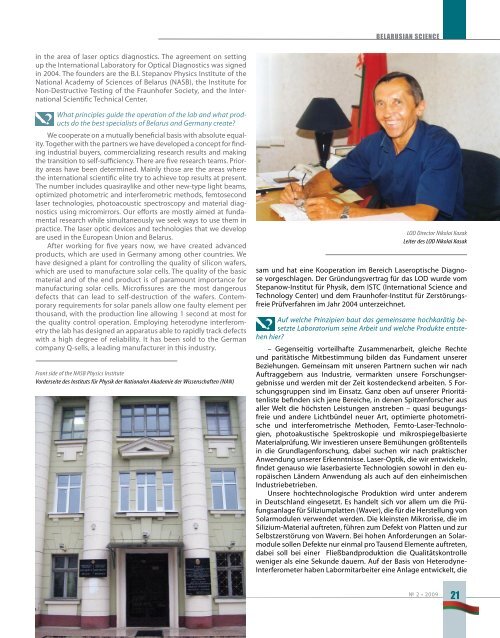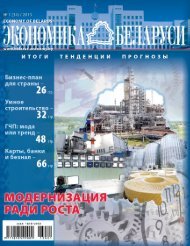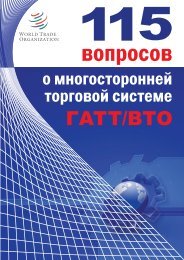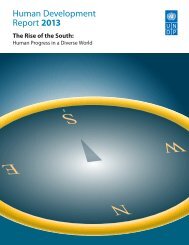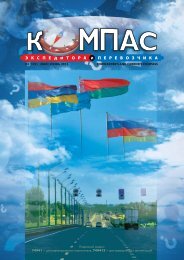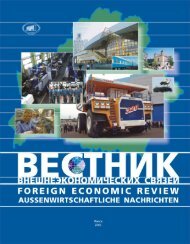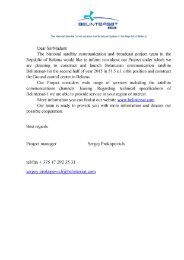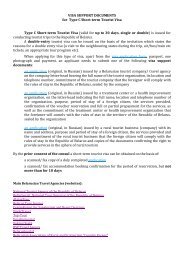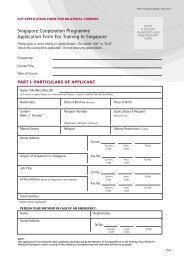BELARus
BELARus
BELARus
Erfolgreiche ePaper selbst erstellen
Machen Sie aus Ihren PDF Publikationen ein blätterbares Flipbook mit unserer einzigartigen Google optimierten e-Paper Software.
in the area of laser optics diagnostics. The agreement on setting<br />
up the International Laboratory for Optical Diagnostics was signed<br />
in 2004. The founders are the B.I. Stepanov Physics Institute of the<br />
National Academy of Sciences of Belarus (NASB), the Institute for<br />
Non-Destructive Testing of the Fraunhofer Society, and the International<br />
Scientific Technical Center.<br />
What principles guide the operation of the lab and what products<br />
do the best specialists of Belarus and Germany create?<br />
We cooperate on a mutually beneficial basis with absolute equality.<br />
Together with the partners we have developed a concept for finding<br />
industrial buyers, commercializing research results and making<br />
the transition to self-sufficiency. There are five research teams. Priority<br />
areas have been determined. Mainly those are the areas where<br />
the international scientific elite try to achieve top results at present.<br />
The number includes quasiraylike and other new-type light beams,<br />
optimized photometric and interferometric methods, femtosecond<br />
laser technologies, photoacoustic spectroscopy and material diagnostics<br />
using micromirrors. Our efforts are mostly aimed at fundamental<br />
research while simultaneously we seek ways to use them in<br />
practice. The laser optic devices and technologies that we develop<br />
are used in the European Union and Belarus.<br />
After working for five years now, we have created advanced<br />
products, which are used in Germany among other countries. We<br />
have designed a plant for controlling the quality of silicon wafers,<br />
which are used to manufacture solar cells. The quality of the basic<br />
material and of the end product is of paramount importance for<br />
manufacturing solar cells. Microfissures are the most dangerous<br />
defects that can lead to self-destruction of the wafers. Contemporary<br />
requirements for solar panels allow one faulty element per<br />
thousand, with the production line allowing 1 second at most for<br />
the quality control operation. Employing heterodyne interferometry<br />
the lab has designed an apparatus able to rapidly track defects<br />
with a high degree of reliability. It has been sold to the German<br />
company Q-sells, a leading manufacturer in this industry.<br />
Front side of the NASB Physics Institute<br />
Vorderseite des Instituts für Physik der Nationalen Akademie der Wissenschaften (NAN)<br />
BELARuSIAN SCIENCE<br />
LOD Director Nikolai Kazak<br />
Leiter des LOD Nikolai Kasak<br />
sam und hat eine Kooperation im Bereich Laseroptische Diagnose<br />
vorgeschlagen. Der Gründungsvertrag für das LOD wurde vom<br />
Stepanow-Institut für Physik, dem ISTC (International Science and<br />
Technology Center) und dem Fraunhofer-Institut für Zerstörungsfreie<br />
Prüfverfahren im Jahr 2004 unterzeichnet.<br />
Auf welche Prinzipien baut das gemeinsame hochkarätig besetzte<br />
Laboratorium seine Arbeit und welche Produkte entstehen<br />
hier?<br />
– Gegenseitig vorteilhafte Zusammenarbeit, gleiche Rechte<br />
und paritätische Mitbestimmung bilden das Fundament unserer<br />
Beziehungen. Gemeinsam mit unseren Partnern suchen wir nach<br />
Auftraggebern aus Industrie, vermarkten unsere Forschungsergebnisse<br />
und werden mit der Zeit kostendeckend arbeiten. 5 Forschungsgruppen<br />
sind im Einsatz. Ganz oben auf unserer Prioritätenliste<br />
befinden sich jene Bereiche, in denen Spitzenforscher aus<br />
aller Welt die höchsten Leistungen anstreben – quasi beugungsfreie<br />
und andere Lichtbündel neuer Art, optimierte photometrische<br />
und interferometrische Methoden, Femto-Laser-Technologien,<br />
photoakustische Spektroskopie und mikrospiegelbasierte<br />
Materialprüfung. Wir investieren unsere Bemühungen größtenteils<br />
in die Grundlagenforschung, dabei suchen wir nach praktischer<br />
Anwendung unserer Erkenntnisse. Laser-Optik, die wir entwickeln,<br />
findet genauso wie laserbasierte Technologien sowohl in den europäischen<br />
Ländern Anwendung als auch auf den einheimischen<br />
Industriebetrieben.<br />
Unsere hochtechnologische Produktion wird unter anderem<br />
in Deutschland eingesetzt. Es handelt sich vor allem um die Prüfungsanlage<br />
für Siliziumplatten (Waver), die für die Herstellung von<br />
Solarmodulen verwendet werden. Die kleinsten Mikrorisse, die im<br />
Silizium-Material auftreten, führen zum Defekt von Platten und zur<br />
Selbstzerstörung von Wavern. Bei hohen Anforderungen an Solarmodule<br />
sollen Defekte nur einmal pro Tausend Elemente auftreten,<br />
dabei soll bei einer Fließbandproduktion die Qualitätskontrolle<br />
weniger als eine Sekunde dauern. Auf der Basis von Heterodyne-<br />
Interferometer haben Labormitarbeiter eine Anlage entwickelt, die<br />
№ 2 • 2009<br />
21


